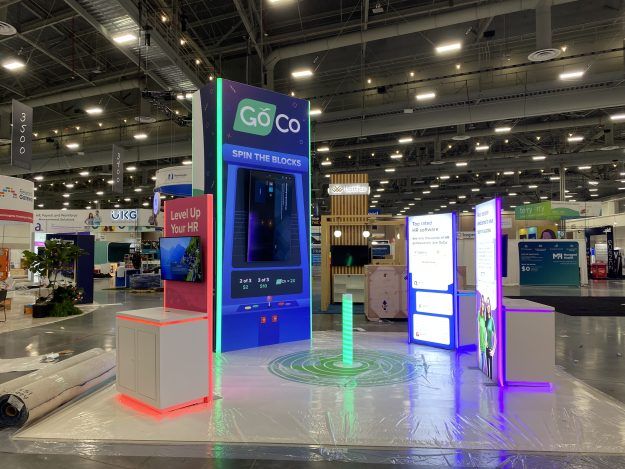For industry networking, product introductions, and business development, trade exhibits have long been essential centers of activity. The conventional display layout is changing to become something more dynamic, customized, and quantifiable. Knowing these new tendencies helps one to have an important understanding of how trade events will run in the next years. The main developments altering the trade show scene and how these developments will impact exhibitors, visitors, and event planners from several sectors are investigated in this article.
Hybrid Event Models Becoming Standard
Putting together real and virtual parts has changed the framework of trade shows in a way that can’t be changed. You can now take part in events that combine real-life and online activities in a way that makes them easy to do from anywhere. Virtual components link worldwide viewers with exhibitors, therefore extending the event reach well beyond physical constraints. With live-streamed seminars, virtual booth tours, and remote networking possibilities, digital platforms enhance physical events. Depending on taste, scheduling, and financial constraints, attendees negotiate between digital access and actual presence. Even conventional 10×20 booth areas increasingly include digital components like QR codes, which create interactive product demos or enlarged virtual showrooms. Designing integrated experiences from the first planning phases, event organizers see physical and digital elements as complimentary rather than competitive.
Immersive Technologies Enhancing Experiences
Modern technology is turning visits to passive booths into engaging experiences. Products can now be seen through augmented reality overlays showing functioning without actual objects present. Virtual reality environments show solutions in contextually relevant surroundings and carry visitors into simulated application scenarios. Through three-dimensional representations, holographic displays produce visually striking images that communicate difficult information. Interactive touch screens let users explore product catalogs, specifications, and customizing choices under directions. Based on attendee profiles and past encounters, facial recognition technology tailors interactions. These immersive technologies show items too big, sophisticated, or dangerous for physical display, therefore transcending conventional exhibition constraints.
Sustainability Driving Exhibition Design
Every element of trade show planning and execution is now influenced in great part by environmental issues. This change is evident in modular booth designs created especially for several reuses throughout different event venues. Instead of conventional petroleum-based choices, sustainable materials such as bamboo, recycled textiles, and biodegradable substitutes are taking the stage. While allowing real-time content upgrades, digital signage solutions eradicate waste from single-use printed materials. Energy-efficient lighting choices can retain or enhance visual impact while lowering power demand. Programs for carbon offsets help to mitigate the environmental effects of participant travel and venue operations. Waste management systems guarantee that items are either correctly composted or repurposed instead of dumped into landfills. These sustainability projects fit business environmental goals and respond to growing regulatory needs. Beyond mere compliance, sustainable practices build good brand relationships with environmentally minded guests.
Data-Driven Personalization Transforming Engagement
Modern data collecting and analysis tools are transforming exhibitor interaction with guests. As exhibitors use data to customize interactions to your particular requirements and interests, you may enjoy ever more customized involvement. Tracking mobility patterns, booth visits, content engagements, RFID badges, smartphone apps, and beacon technology helps one better grasp audience preferences. Using this behavioral data, artificial intelligence systems find competent candidates and suggest pertinent presentations or items. Survey answers and pre-event registrations guide customized schedules stressing seminars and exhibitors aligned with individual interests. Depending on industry vertical, job function, or stated demand, digital content delivery systems automatically change information. The most advanced systems produce flawless experiences whereby pertinent information shows exactly where needed without using invasive data-collecting techniques.
Reimagined Networking Facilitated by Technology
Conventions of chance meetings and business card exchanges are turning into more deliberate connecting chances. You can now use advanced matchmaking platforms that find suitable contacts for you based on shared hobbies, business needs that complement each other, and specific goals. AI-powered networking algorithms suggest possible links based on how well they match your stated goals and how you’ve interacted with others in the past. Scheduling systems suggest meeting times depending on both parties’ availability throughout the event, therefore removing coordination problems. Technologies meant to enable deep conversations rather than surface interactions abound in dedicated networking areas. Digital contact exchange systems replace actual business cards by instantaneously forwarding thorough professional profiles. Post-event platforms offer solutions for planned follow-up questions and relationship building, therefore preserving the ties started during shows. These technical improvements eliminate inefficiencies from random contacts and solve the main attendee’s drive to create meaningful connections.
Conclusion
Trade exhibits of the future embrace technological innovation while nevertheless honoring the priceless importance of in-person contact. These developments create fresh opportunities for involvement, assessment, and return on investment, as well as solve long-standing exhibition problems. Forward-looking companies see these changes as strategic possibilities to differentiate their presence and interact with audiences in more meaningful ways, not only as operational concerns.

